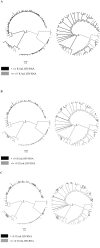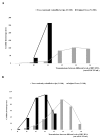Near Full-length Genomic Sequencing and Molecular Analysis of HIV-Infected Individuals in a Network-based Intervention (TRIP) in Athens, Greece: Evidence that Transmissions Occur More Frequently from those with High HIV-RNA
- PMID: 30706819
- PMCID: PMC6446520
- DOI: 10.2174/1570162X17666190130120757
Near Full-length Genomic Sequencing and Molecular Analysis of HIV-Infected Individuals in a Network-based Intervention (TRIP) in Athens, Greece: Evidence that Transmissions Occur More Frequently from those with High HIV-RNA
Abstract
Background: TRIP (Transmission Reduction Intervention Project) was a network-based, contact tracing approach to locate and link to care, mostly people who inject drugs (PWID) with recent HIV infection.
Objective: We investigated whether sequences from HIV-infected participants with high viral load cluster together more frequently than what is expected by chance.
Methods: Paired end reads were generated for 104 samples using Illumina MiSeq next-generation sequencing.
Results: 63 sequences belonged to previously identified local transmission networks of PWID (LTNs) of an HIV outbreak in Athens, Greece. For two HIV-RNA cut-offs (105 and 106 IU/mL), HIV transmissions were more likely between PWID with similar levels of HIV-RNA (p<0.001). 10 of the 14 sequences (71.4%) from PWID with HIV-RNA >106 IU/mL were clustered in 5 pairs. For 4 of these clusters (80%), there was in each one of them at least one sequence from a recently HIVinfected PWID.
Conclusion: We showed that transmissions are more likely among PWID with high viremia.
Keywords: HIV; HIV transmission; HIV-RNA; PWID; TRIP; recent infection..
Copyright© Bentham Science Publishers; For any queries, please email at epub@benthamscience.net.
Figures


Similar articles
-
Detailed Molecular Surveillance of the HIV-1 Outbreak Among People who Inject Drugs (PWID) in Athens During a Period of Four Years.Curr HIV Res. 2017;15(6):396-404. doi: 10.2174/1570162X15666171120104048. Curr HIV Res. 2017. PMID: 29165088
-
Molecular epidemiology of HIV among people who inject drugs after the HIV-outbreak in Athens, Greece: Evidence for a 'slow burn' outbreak.Infect Genet Evol. 2024 Jul;121:105597. doi: 10.1016/j.meegid.2024.105597. Epub 2024 Apr 23. Infect Genet Evol. 2024. PMID: 38663466
-
Molecular Tracing of the Geographical Origin of Human Immunodeficiency Virus Type 1 Infection and Patterns of Epidemic Spread Among Migrants Who Inject Drugs in Athens.Clin Infect Dis. 2017 Nov 29;65(12):2078-2084. doi: 10.1093/cid/cix717. Clin Infect Dis. 2017. PMID: 29020180 Free PMC article.
-
Key harm reduction interventions and their impact on the reduction of risky behavior and HIV incidence among people who inject drugs in low-income and middle-income countries.Curr Opin HIV AIDS. 2012 Jul;7(4):362-8. doi: 10.1097/COH.0b013e328354a0b5. Curr Opin HIV AIDS. 2012. PMID: 22647588 Review.
-
Overview of HIV molecular epidemiology among people who inject drugs in Europe and Asia.Infect Genet Evol. 2016 Dec;46:256-268. doi: 10.1016/j.meegid.2016.06.017. Epub 2016 Jun 7. Infect Genet Evol. 2016. PMID: 27287560 Free PMC article. Review.
Cited by
-
A Nationwide Study about the Dispersal Patterns of the Predominant HIV-1 Subtypes A1 and B in Greece: Inference of the Molecular Transmission Clusters.Viruses. 2020 Oct 19;12(10):1183. doi: 10.3390/v12101183. Viruses. 2020. PMID: 33086773 Free PMC article.
-
Exploring HIV-1 Transmission Dynamics by Combining Phylogenetic Analysis and Infection Timing.Viruses. 2019 Nov 26;11(12):1096. doi: 10.3390/v11121096. Viruses. 2019. PMID: 31779195 Free PMC article.
-
Phylodynamics Helps to Evaluate the Impact of an HIV Prevention Intervention.Viruses. 2020 Apr 20;12(4):469. doi: 10.3390/v12040469. Viruses. 2020. PMID: 32326127 Free PMC article.
References
-
- Friedman S.R., Kottiri B.J., Neaigus A., et al. Network-related mechanisms may help explain long-term HIV-1 seroprevalence levels that remain high but do not approach population-group saturation. Am. J. Epidemiol. 2000;152:913–922. - PubMed
Publication types
MeSH terms
Substances
Grants and funding
LinkOut - more resources
Full Text Sources
Medical

